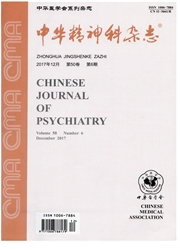

 中文摘要:
中文摘要:
目的探究抑郁症患者和健康人在情绪处理过程中早期皮质下通路是否受到负性情绪刺激影响,以及抑郁症患者情绪处理早期皮质下通路是否存在异常。方法利用脑磁图检测19例抑郁症患者(抑郁症组)和17名相匹配的健康对照者(对照组)在识别负性情绪面孔时的脑活动。选取丘脑、初级视觉皮质、梭状回、颞下回、杏仁核、眶额回作为感兴趣脑区,0~100、0~150、0~200 ms分别为感兴趣时间窗,建立感兴趣模型。通过动态因果模型及贝叶斯模型方法得出最优模型。在最优模型下,用非参数检验方法比较2组的效能连接差异。结果贝叶斯模型选择结果显示,对照组在0~100 ms时受到情绪刺激的影响,而抑郁症组在150~200 ms时受到情绪刺激的影响。在0~100 ms时,抑郁症组左侧初级视觉皮质到眶额回调制连接显著下降(P=0.01),右侧丘脑到眶额回的固有连接下降(P=0.04)。在0~150 ms时,抑郁症组右侧初级视觉皮质到眶额回的固有连接显著增强(P=0.01)。在0~200 ms时,抑郁症组左侧丘脑到眶额回调制连接下降(P=0.04),右侧丘脑到杏仁核固有连接显著下降(P=0.04)。结论抑郁症患者情绪处理早期阶段不同于健康人,处于动态变化过程,且视觉皮质与眶额回之间的相互作用在情绪处理早期便出现异常。
 英文摘要:
英文摘要:
Objective To explore whether the early automatic subcortical pathway was modulated by the negative emotional stimuli in the major depressive patients and healthy controls, as well as the aberrant functional connectivity of the subcortical pathway in the major depressive patients. Methods The technology of the magnetoencephalograph was used to record the brain response when 19 depressed patients and 17 healthy controls were under the negative emotion recognition task. The interested brain areas were the thalamus, the primary visual cortex, the fusiform gyrus, the inferior temporal cortex, the orbitofrontal cortex and the amygdala, and the interested time periods in this study were 0-100 ms, 0-150 ms, and 0-200 ms. The dynamic causal modeling was selected to compute the constructed model, and the Bayesian model was used to pick out the best model. Under the best model, the parameters of effective connectivity were analyzed with the method of permutation. Results By Bayesian model selection, the subjects in healthy control responded to the negative emotion stimuli at as early as 0-100 ms, while the depressed patients responded at as early as 150- 200 ms. During the period of 0- 100 ms, the depressed patients presented reduced modulatory effect of the task on connection from left primary visual cortex to left orbitofrontal cortex (P= 0.01), and reduced activity of intrinsic connectivity from right thalamus to right orbitofrontal cortex (P=0.04).During the period of 0-150 ms, the depressed patients increased activity of intrinsic connectivity from right primary visual cortex to right orbitofrontal cortex (P=0.01). During the period of 0-200 ms, the depressed patients reduced modulatory effect on connection from left thalamus to left orbitofrontal cortex (P=0.04), and reduced the activity of intrinsic connectivity from the right thalamus to right amygdala (P=0.04). Conclusions During the early period of the emotion processing stage, the depressed patients display delayed perception of negative emoti
 同期刊论文项目
同期刊论文项目
 同项目期刊论文
同项目期刊论文
 期刊信息
期刊信息
